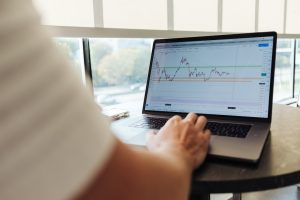Swing trading is a popular trading strategy that involves holding trades for a few days to a few weeks in order to profit from short-term price movements. In forex trading, swing trading is often employed by traders who want to take advantage of short-term volatility in the currency markets. One popular tool used by forex swing traders is moving averages. In this article, we’ll explain how to swing trade forex with moving averages.
What are Moving Averages?
Moving averages are a technical indicator that helps traders to identify trends in the market. They are calculated by taking the average price of a currency pair over a set period of time. For example, a 50-day moving average would be calculated by taking the average price of a currency pair over the past 50 days.
Moving averages are useful because they smooth out short-term price fluctuations, making it easier to identify the underlying trend. Traders use moving averages in a variety of ways, but one common approach is to use them to identify support and resistance levels.
How to Use Moving Averages for Swing Trading
Before we dive into the specifics of how to use moving averages for swing trading, it’s important to note that there are many different types of moving averages. The most commonly used moving averages are simple moving averages (SMA) and exponential moving averages (EMA). Both types of moving averages are calculated differently, but they are both useful for identifying trends in the market.
To use moving averages for swing trading, traders typically use two different moving averages – a longer-term moving average and a shorter-term moving average. For example, a trader might use a 50-day SMA as the longer-term moving average and a 20-day SMA as the shorter-term moving average.
The idea behind this approach is that when the shorter-term moving average crosses above the longer-term moving average, it indicates that the trend is bullish and traders should look for buying opportunities. Conversely, when the shorter-term moving average crosses below the longer-term moving average, it indicates that the trend is bearish and traders should look for selling opportunities.
It’s important to note that moving averages are lagging indicators, which means that they are based on past price data. This means that the crossover signals may not be perfectly timed with the start of a new trend. However, for swing traders who are looking to hold positions for a few days to a few weeks, this lag may not be a significant issue.
How to Enter and Exit Trades Using Moving Averages
Once you have identified a bullish or bearish trend using moving averages, the next step is to identify entry and exit points. There are a few different approaches that traders can use to enter and exit trades using moving averages.
One approach is to enter a long position (buy) when the shorter-term moving average crosses above the longer-term moving average and exit the position when the shorter-term moving average crosses below the longer-term moving average. Conversely, traders can enter a short position (sell) when the shorter-term moving average crosses below the longer-term moving average and exit the position when the shorter-term moving average crosses above the longer-term moving average.
Another approach is to use the moving averages as dynamic support and resistance levels. For example, if the price of a currency pair is approaching the longer-term moving average from below and the shorter-term moving average is still above the longer-term moving average, it may be a good opportunity to enter a long position. Conversely, if the price of a currency pair is approaching the longer-term moving average from above and the shorter-term moving average is still below the longer-term moving average, it may be a good opportunity to enter a short position.
Final Thoughts
Swing trading forex with moving averages can be an effective way to profit from short-term price movements in the market. By using two different moving averages and looking for crossover signals, traders can identify bullish and bearish trends in the market. From there, traders can use the moving averages as dynamic support and resistance levels to identify entry and exit points. As with any trading strategy, it’s important to backtest and practice before risking real money in the market.





